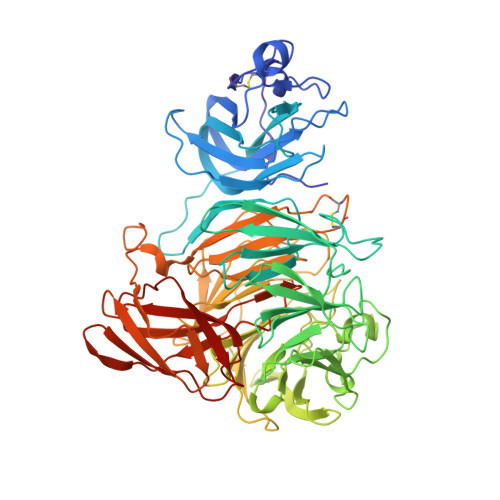Formation of Monofluorinated Radical Cofactor in Galactose Oxidase through Copper-Mediated C-F Bond Scission.
Li, J., Davis, I., Griffith, W.P., Liu, A.(2020) J Am Chem Soc 142: 18753-18757
- PubMed: 33091303
- DOI: https://doi.org/10.1021/jacs.0c08992
- Primary Citation of Related Structures:
6XLR, 6XLS, 6XLT - PubMed Abstract:
Galactose oxidase (GAO) contains a Cu(II)-ligand radical cofactor. The cofactor, which is autocatalytically generated through the oxidation of the copper, consists of a cysteine-tyrosine radical (Cys-Tyr • ) as a copper ligand. The formation of the cross-linked thioether bond is accompanied by a C-H bond scission on Tyr272 with few details known thus far. Here, we report the genetic incorporation of 3,5-dichlorotyrosine (Cl 2 -Tyr) and 3,5-difluorotyrosine (F 2 -Tyr) to replace Tyr272 in the GAO V previously optimized for expression through directed evolution. The proteins with an unnatural tyrosine residue are catalytically competent. We determined the high-resolution crystal structures of the GAO V , Cl 2 -Tyr272, and F 2 -Tyr272 incorporated variants at 1.48, 1.23, and 1.80 Å resolution, respectively. The structural data showed only one halogen remained in the cofactor, indicating that an oxidative carbon-chlorine/fluorine bond scission has occurred during the autocatalytic process of cofactor biogenesis. Using hydroxyurea as a radical scavenger, the spin-coupled hidden Cu(II) was observed by EPR spectroscopy. Thus, the structurally defined catalytic center with genetic unnatural tyrosine substitution is in the radical containing form as in the wild-type, i.e., Cu(II)-(Cl-Tyr • -Cys) or Cu(II)-(F-Tyr • -Cys). These findings illustrate a previously unobserved C-F/C-Cl bond cleavage in biology mediated by a mononuclear copper center.
Organizational Affiliation:
Department of Chemistry, The University of Texas at San Antonio, San Antonio, Texas 78249, United States.


















